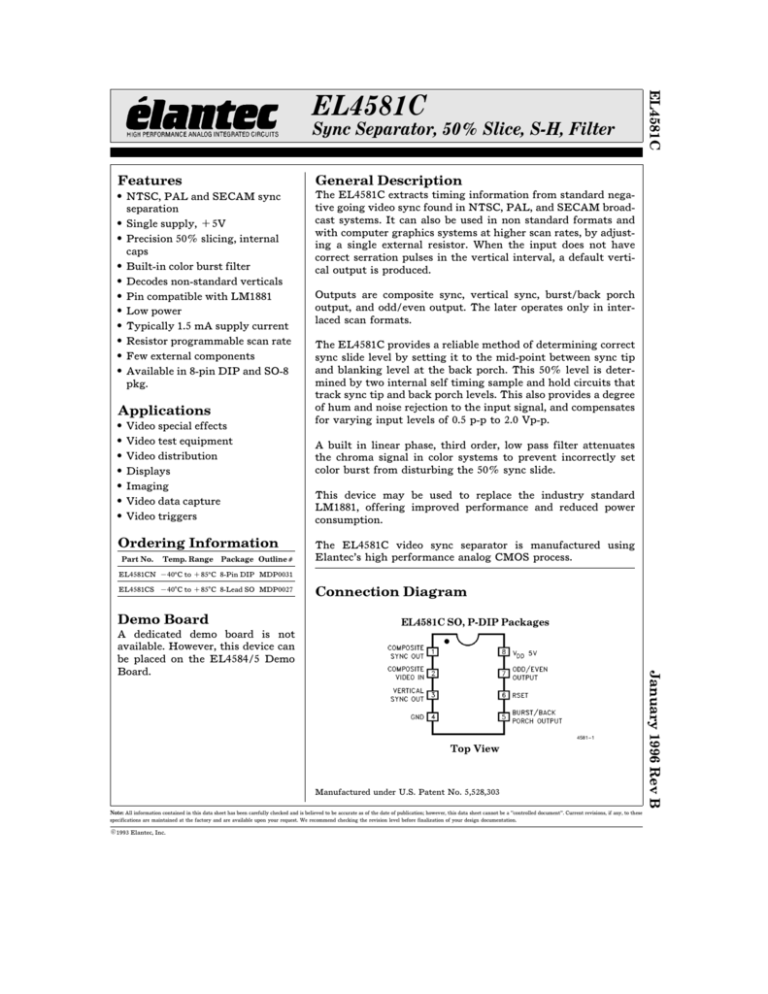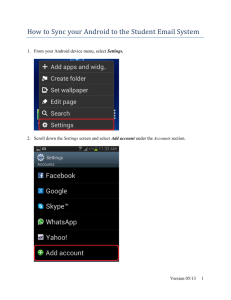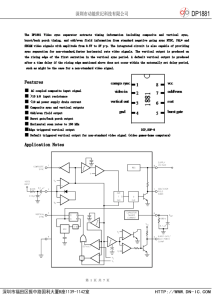EL4581C - F5AD
advertisement

Sync Separator, 50% Slice, S-H, Filter Features General Description # NTSC, PAL and SECAM sync separation # Single supply, a 5V # Precision 50% slicing, internal caps # Built-in color burst filter # Decodes non-standard verticals # Pin compatible with LM1881 # Low power # Typically 1.5 mA supply current # Resistor programmable scan rate # Few external components # Available in 8-pin DIP and SO-8 pkg. The EL4581C extracts timing information from standard negative going video sync found in NTSC, PAL, and SECAM broadcast systems. It can also be used in non standard formats and with computer graphics systems at higher scan rates, by adjusting a single external resistor. When the input does not have correct serration pulses in the vertical interval, a default vertical output is produced. Applications # # # # # # # Video special effects Video test equipment Video distribution Displays Imaging Video data capture Video triggers Ordering Information Part No. Temp. Range Package OutlineÝ EL4581C EL4581C Outputs are composite sync, vertical sync, burst/back porch output, and odd/even output. The later operates only in interlaced scan formats. The EL4581C provides a reliable method of determining correct sync slide level by setting it to the mid-point between sync tip and blanking level at the back porch. This 50% level is determined by two internal self timing sample and hold circuits that track sync tip and back porch levels. This also provides a degree of hum and noise rejection to the input signal, and compensates for varying input levels of 0.5 p-p to 2.0 Vp-p. A built in linear phase, third order, low pass filter attenuates the chroma signal in color systems to prevent incorrectly set color burst from disturbing the 50% sync slide. This device may be used to replace the industry standard LM1881, offering improved performance and reduced power consumption. The EL4581C video sync separator is manufactured using Elantec’s high performance analog CMOS process. EL4581CN b 40§ C to a 85§ C 8-Pin DIP MDP0031 EL4581CS b 40§ C to a 85§ C 8-Lead SO MDP0027 Demo Board Connection Diagram EL4581C SO, P-DIP Packages 4581 – 1 Top View Manufactured under U.S. Patent No. 5,528,303 Note: All information contained in this data sheet has been carefully checked and is believed to be accurate as of the date of publication; however, this data sheet cannot be a ‘‘controlled document’’. Current revisions, if any, to these specifications are maintained at the factory and are available upon your request. We recommend checking the revision level before finalization of your design documentation. © 1993 Elantec, Inc. January 1996 Rev B A dedicated demo board is not available. However, this device can be placed on the EL4584/5 Demo Board. EL4581C Sync Separator, 50% Slice, S-H, Filter Absolute Maximum Ratings (TA e 25§ C) VCC Supply 7V Storage Temperature b 0.5V to VCC a 0.5V Pin Voltages b 65§ C to a 150§ C Operating Temperature Range b 40§ C to a 85§ C 260§ C Lead Temperature Important Note: All parameters having Min/Max specifications are guaranteed. The Test Level column indicates the specific device testing actually performed during production and Quality inspection. Elantec performs most electrical tests using modern high-speed automatic test equipment, specifically the LTX77 Series system. Unless otherwise noted, all tests are pulsed tests, therefore TJ e TC e TA. Test Level I II III IV V Test Procedure 100% production tested and QA sample tested per QA test plan QCX0002. 100% production tested at TA e 25§ C and QA sample tested at TA e 25§ C , TMAX and TMIN per QA test plan QCX0002. QA sample tested per QA test plan QCX0002. Parameter is guaranteed (but not tested) by Design and Characterization Data. Parameter is typical value at TA e 25§ C for information purposes only. Parameter Description Temp Min Typ Max Test Level Units 25§ C 0.75 1.7 3 I mA IDD VDD e 5V (Note 1) Clamp Voltage Pin 2, Unloaded 25§ C 1.3 1.5 1.9 I V Discharge Current Pin 2 e 2V 25§ C 6 10 20 I mA Clamp Charge Current Pin 2, VIN e 1V 25§ C 2 3 I mA Ref Voltage Pin 6, VDD e 5V (Note 2) 25§ C 1.5 1.8 VOL Output Low Voltage IOL e 1.6 mA 25§ C VOH Output High Voltage IOH e b40 mA IOH e b1.6 mA 25§ C 4 2.4 Note 1: No video signal, outputs unloaded. Note 2: Tested for VDD 5V g 5% which guarantees timing of output pulses over this range. 2 2.1 I V 800 I mV IV I V TD is 1.8in DC Electrical Characteristics Unless otherwise state VDD e 5V, TA e 25§ C, Rset e 680 kX. EL4581C Sync Separator, 50% Slice, S-H, Filter Dynamic Characteristics Parameter Description Vertical Sync Width, tVS (Note 3) Burst/Back Porch Width, tB (Note 3) Vertical Sync Default Delay tVSD Temp Min Typ Max Test Level Units 25§ C 190 230 300 I ms 25§ C 2.5 3.5 4.5 I ms 25§ C 40 55 70 I ms V dB 400 I ns 2 I V 60% 60% I IV Filter Attenuation FIN e 3.4 MHz (Note 4) 25§ C 24 Composite Sync Prop Delay VINb Composite Sync (Note 3) 25§ C 260 Input Dynamic Range p-p NTSC Signal (Note 5) 25§ C 0.5 Slice Level Input Voltage e 1VP-P (Note 6) 25§ C Full 40% 40% Note Note Note Note 50% 50% 3: C/S, Vertical and Burst outputs are all active low b VOH e 2.4V, VOL e 0.8V. 4: Attenuation is a function of Rset (PIN6). 5: Typical min. is 0.3 VP-P. 6: Refers to threshold level of sync. tip to back porch amplitude. Pin Descriptions Pin No. Pin Name Function 1 Composite Sync Out Composite sync pulse output. Sync pulses start on a falling edge and end on a rising edge. 2 Composite Video in AC coupled composite video input. Sync tip must be at the lowest potential (Positive picture phase). 3 Vertical Sync Out Vertical sync pulse output. The falling edge of Vert Sync is the start of the vertical period. 4 GND Supply ground. 5 Burst/Back Porch Output Burst/Back porch output. Low during burst portion of composite video. 6 RSET An external resistor to ground sets all internal timing. 681k, 1% resistor will provide correct timing for NTSC signals. 7 Odd/Even Output Odd/Even field output. Low during odd fields, high during even fields. Transitions occur at start of Vert Sync pulse. 8 VDD 5V Positive supply. (5V) Note: RSET must be a 1% resistor. 3 TD is 2.0in VDD e 5V, IV pk-pk video, TA e 25§ C, CL e 15 pF, IOH e b1.6 mA, IOL e 1.6 mA. Signal voltages are peak to peak. EL4581C Sync Separator, 50% Slice, S-H, Filter Typical Performance Characteristics RSET vs Horizontal Frequency Back Porch Clamp On Time vs RSET Vertical Pulse Width vs RSET Vertical Default Delay Time vs RSET Vertical Pulse Width vs Temperature Supply Current vs Temperature Input Signal e 300 mVP-P EL4581 Filter Characteristic Constant Delay 240 ns 4581 – 2 4 EL4581C Sync Separator, 50% Slice, S-H, Filter Timing Diagrams 4581 – 3 Figure 1 Notes: b. The composite sync output reproduces all the video input sync pulses, with a propagation delay. c. Vertical sync leading edge is coincident with the first vertical serration pulse leading edge, with a propagation delay. d. Odd-even output is low for even field, and high for odd field. e. Back porch goes low for a fixed pulse width on the trailing edge of video input sync pulses. Note that for serration pulses during vertical, the back porch starts on the rising edge of the serration pulse (with propagation delay). 5 EL4581C Sync Separator, 50% Slice, S-H, Filter 4581 – 5 Figure 2 4581 – 6 Figure 3 6 EL4581C Sync Separator, 50% Slice, S-H, Filter 4581 – 7 Figure 4. Standard (NTSC Input) H. Sync Detail 7 EL4581C Sync Separator, 50% Slice, S-H, Filter video signal by 6 dB to improve the detection accuracy. Note that the filter cut-off frequency is a function of RSET through IOT and is proportional to IOT. Description of Operation A simplified block schematic is shown in Figure 2. The following description is intended to provide the user with sufficient information to be able to understand the effects that the external components and signal conditions have on the outputs of the integrated circuit. Internal reference voltages (block VREF) with high immunity to supply voltage variation are derived on the chip. Reference VR4 with op-amp A2 forces pin 6 to a reference voltage of 1.7V nominal. Consequently, it can be seen that the external resistance RSET will determine the value of the reference current ITR. The internal resistance R3 is only about 6 kX, much less than RSET. All the internal timing functions on the chip are referenced to ITR and have excellent supply voltage rejection. The video signal is AC coupled to pin 2 via the capacitor C1, nominally 0.1 mF. The clamp circuit A1 will prevent the input signal on pin 2 going any more negative than 1.5V, the value of reference voltage VR1. Thus the sync tip, the most negative part of the video waveform, will be clamped at 1.5V. The current source I1, nominally 10 mA, charges the coupling capacitor during the remaining portion of the H line, approximately 58 ms for a 15.75 kHz timebase. From I # t e C # V, the video time-constant can be calculated. It is important to note that the charge taken from the capacitor during video must be replaced during the sync tip time, which is much shorter, (ratio of x 12.5). The corresponding current to restore the charge during sync will therefore be an order of magnitude higher, and any resistance in series with CI will cause sync tip crushing. For this reason, the internal series resistance has been minimized and external high resistance values in series with the input coupling capacitor should be avoided. The user can exercise some control over the value of the input time constant by introducing an external pull-up resistance from pin 2 to the 5V supply. The maximum voltage across the resistance will be VDD less 1.5V, for black level. For a net discharge current greater than zero, the resistance should be greater than 450k. This will have the effect of increasing the time constant and reducing the degree of picture tilt. The current source I1 directly tracks reference current ITR and thus increases with scan rate adjustment, as explained later. Comparator C2 on the input to the sample and hold block (S/H) compares the leading and trailing edges of the sync. pulse with a threshold voltage VR2 which is referenced at a fixed level above the clamp voltage VR1. The output of C2 initiates the timing one-shots for gating the sample and hold circuits. The sample of the sync tip is delayed by 0.8 ms to enable the actual sample of 2 ms to be taken on the optimum section of the sync. pulse tip. The acquisition time of the circuit is about three horizontal lines. The double poly CMOS technology enables long time constants to be achieved with small high quality on-chip capacitors. The back porch voltage is similarly derived from the trailing edge of sync, which also serves to cut off the tip sample if the gate time exceeds the tip period. Note that the sample and hold gating times will track RSET through IOT. The 50% level of the sync tip is derived, through the resistor divider R1 and R2, from the sample and held voltages VTIP and VBP, and applied to the plus input of comparator C1. This comparator has built in hysteresis to avoid false triggering. The output of C2 is a digital 5V signal which feeds the C/S ouput buffer B1 and the other internal circuit blocks, the vertical, back porch and odd/even functions. The signal is processed through an active 3 pole filter (F1) designed for minimum ripple with constant phase delay. The filter attenuates the color burst by 24 dB and eliminates fast transient spikes without sync crushing. An external filter is not necessary. The filter also amplifies the The vertical circuit senses the C/S edges and initiates an integrator which is reset by the shorter horizontal sync pulses but times out the longer 8 EL4581C Sync Separator, 50% Slice, S-H, Filter The odd/even circuit (O/E) comprises of flip flops which track the relationship of the horizontal pulses to the leading edge of the vertical output, and will switch on every field at the start of vertical. Pin 7 is high during the odd field. Description of Operation Ð Contd. vertical sync. pulse widths. The internal timing circuits are referenced to IOT and VR3, the timeout period being inversely proportional to the timing current. The vertical output pulse is started on the first serration pulse in the vertical interval and is then self-timed out. In the absense of a serration pulse, an internal timer will default the start of vertical. Loss of video signal can be detected by monitoring the C/S output. The 50% level of the previous video signal will remain held on the S/H capacitors after the input video signal has gone and the input on pin 2 has defaulted to the clamp voltage. Consequently the C/S output will remain low longer than the normal vertical pulse period. An external timing circuit could be used to detect this condition. The back porch is triggered from the sync tip trailing edge and initiates a one-shot pulse. The period of this pulse is again a function of IOT and will therefore track the scan rate set by RSET. Block Diagram 4581 – 4 Figure 5 *Note: RSET must be a 1% resistor. 9 10 BLANK 11 BLANK EL4581C EL4581C Sync Separator, 50% Slice, S-H, Filter General Disclaimer Specifications contained in this data sheet are in effect as of the publication date shown. Elantec, Inc. reserves the right to make changes in the circuitry or specifications contained herein at any time without notice. Elantec, Inc. assumes no responsibility for the use of any circuits described herein and makes no representations that they are free from patent infringement. January 1996 Rev B WARNING Ð Life Support Policy Elantec, Inc. products are not authorized for and should not be used within Life Support Systems without the specific written consent of Elantec, Inc. Life Support systems are equipment intended to support or sustain life and whose failure to perform when properly used in accordance with instructions provided can be reasonably expected to result in significant personal injury or death. Users contemplating application of Elantec, Inc. products in Life Support Systems are requested to contact Elantec, Inc. factory headquarters to establish suitable terms & conditions for these applications. Elantec, Inc.’s warranty is limited to replacement of defective components and does not cover injury to persons or property or other consequential damages. Elantec, Inc. 1996 Tarob Court Milpitas, CA 95035 Telephone: (408) 945-1323 (800) 333-6314 Fax: (408) 945-9305 European Office: 44-71-482-4596 12 Printed in U.S.A.







